
March 2020:
Our landing field is available again for students and customers ONLY and we have a new set of waivers to sign for all pilots.
You can download the waivers below and sign & witness the waivers to be scanned to FlyBC E-Mail and also to have the hard copies dropped off with one of our staff.
FlyBC waiver.
WCSC waiver.
HPAC waiver.
 New Square Online Storefront prices listed are
temporary for testing and do not reflect BC PST which has to be added manually if you want to place an order.
New Square Online Storefront prices listed are
temporary for testing and do not reflect BC PST which has to be added manually if you want to place an order.SupAir has a new EN-C ship called the Savage ready to fly in 2020!
Prices have not been set yet but I am sure it will be competitive with Ozone and Gin.
Ozone News Release - lots of new stuff coming out very soon!

DELTA 3 ML size is now available. EN C certification.
It has been a hard job to improve upon the Delta 2, but we are now very happy to launch a wing we think will keep all Delta 2 pilots very happy.

Delta 3 stock colours
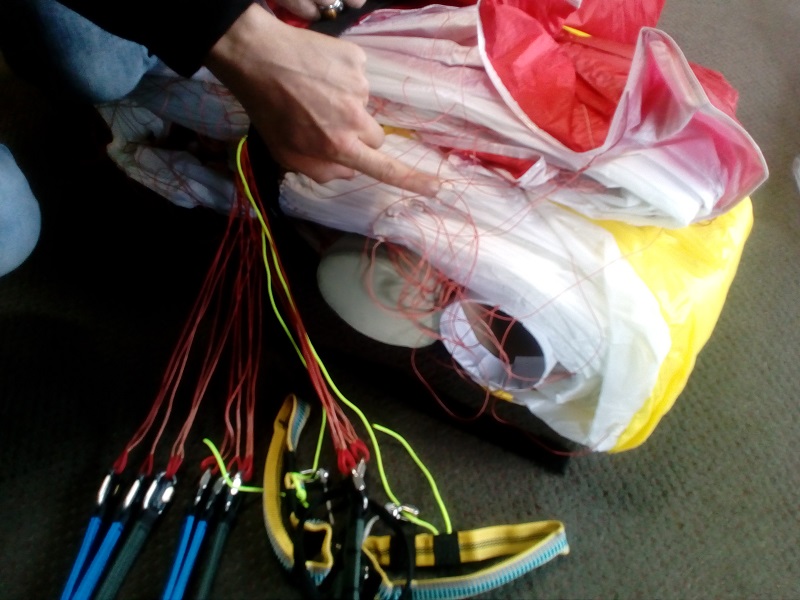
Delta 3 packing pillow and riser setup.
ULTRALITE 4 is now available to order in all sizes. 150g lighter than the Ultralite 3 with better performance, such as more speed, we think this is a worthy successor. We now have all sizes in stock for demo flights.
Ozone Ultralite 4 info here.
OZIUM 2 - making final preparations to launch. We think this is a great improvement and pilots can also save some weight over the Ozium 1!
Announcing the World's First Single Surface Paraglider - from Ozone, of course!
The demo Ozone XXLite 19 arrived this afternoon, and the demo Ozone XXLite 16 arrives next week.
| From November 2012 |
The XXlite Backpack is tiny.
| From November 2012 |
The XXlite weighs 1.2 kilos in the 19 size, good to 115 kgs.
| From November 2012 |
The XXlite packs very compact (30 cms x 40 cms)
CHRIGEL MAURER MOVES FROM ADVANCE TO OZONE
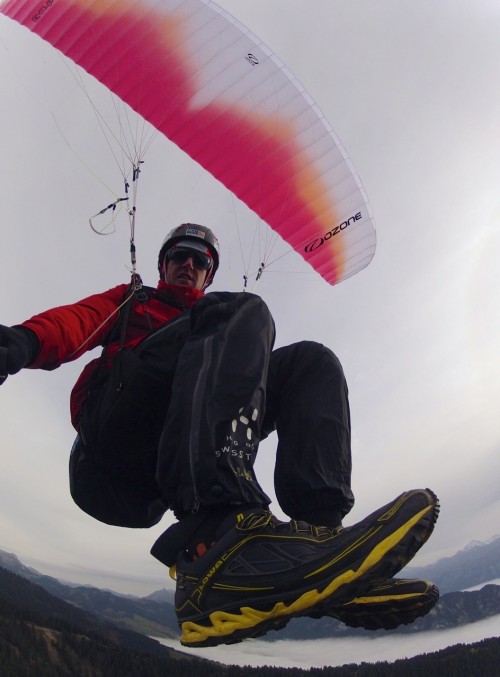 Chrigel Maurer has signed with Ozone. There were some rumours of a possible move away from Advance at St Hilaire, and it will come to many as a surprise that the twice Red Bull X-Alps pilot has decided to leave the brand. The Swiss pilot was hugely involved in harness development � particularly the Impress line. Chrigel told us, �over the rainy days and the long nights of the last few weeks I have thought a lot about my future.�
Chrigel Maurer has signed with Ozone. There were some rumours of a possible move away from Advance at St Hilaire, and it will come to many as a surprise that the twice Red Bull X-Alps pilot has decided to leave the brand. The Swiss pilot was hugely involved in harness development � particularly the Impress line. Chrigel told us, �over the rainy days and the long nights of the last few weeks I have thought a lot about my future.�
He continued, �in January, I will attend the World Cup finals in Colombia in part, with the goal of learning to fly fast again soon. Under the brand Chrigel Maurer I will pass on my knowledge and experience with exclusive tandem flights, in staff training and lectures. And of course, my primary objective is and remains, however, that I can be well prepared in July at the start of the Red Bull X-Alps! �To achieve these goals motivated and confident to tackle, I start from 1 January 2013 independently. For this reason, and so I can work in all facets of paragliding, I will be with Ozone from 1 January.�
Soon after, Advance confirmed Chrigel�s departure. �After a break of several years Chrigel has decided to return to paraglider competition, starting next year,� said Advance�s general manager Simon Campiche. �In doing so he would like to pick up the thread of his competition successes between 2004 and 2007, where he became European Champion and won 3 successive World Cups.� �To complete this list Chrigel has one further competition prize waiting for his name � that of World Champion. Due to radical changes in the competition scene we in ADVANCE have clearly been less involved with competition wings in recent years, and currently are not in a position to provide Chrigel with the relevant equipment.�
I had the opportunity to meet Chigrel in San Marcos, Mexico at a pre-PWC in 2000 on his first comp season and he was already a great pilot then . . . 12 years of experience and some hot new Ozone kit will make him a super star next year for sure! - Jim
More Ozone news here - August 2012
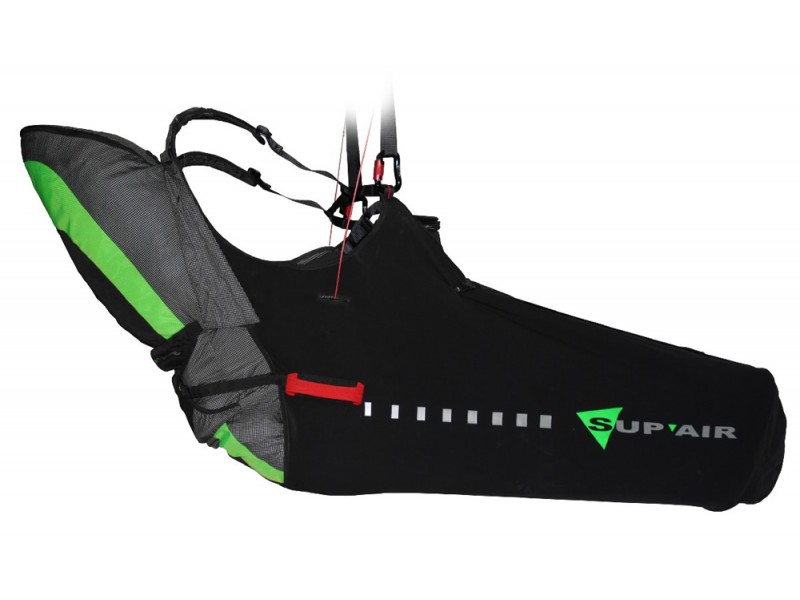
The new SupAir Delight Harness - very light I just received my new SupAir Delight Harness in Fedex this morning and can't wait to fly her in Mexico! Delight Manual here . 2.3 kgs without reserve, comfortable and easy to set-up for different flight angles. Retails for around $1100, far better deal than the Advance Impress 3 at over $1800 USD!
Ozone celebrates Luc's win in Italy on his own design - the Ozone R10.2
Ozone Delta News for those waiting for their 2010 wing refresh, it is nearing production status and worth the wait!
Pepe Wins in Brazil, Again - March 2010 - from Ozone News
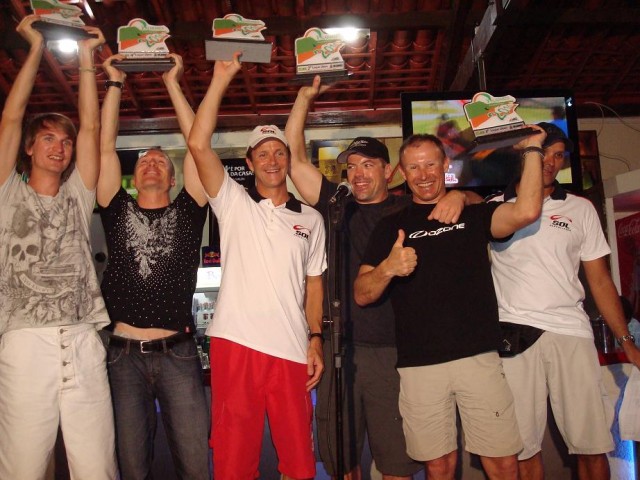 Top Canadian Brett Hazlett came in 4th place flying a borrowed Boom7 in Brazil!
Top Canadian Brett Hazlett came in 4th place flying a borrowed Boom7 in Brazil!
Andreas ‘Pepe’ Malecki has made a strong start to the comp season, winning the Valadares Paragliding Open with his new Mantra R10.2!
Pepe won 5 out of the 7 tasks and it was said that the R10.2 had a clear performance advantage over every other wing in the competition, although Pepe is not a stranger to winning comps in Brazil, where he stood on the podium barely one year ago for the PWC (click here).
Congratulations Pepe, from all the Team, we’re so happy to have you flying Ozone and we’re glad you like your new wing ![]()
Full Valadares Open Comp results here.
The R10 is now shipping to pilots all over the world, and is available in two versions: the R10.2 (2 line version) and R10 (3 lines). For more info, contact us here at FlyBC, Ozone's largest Canadian Dealer.
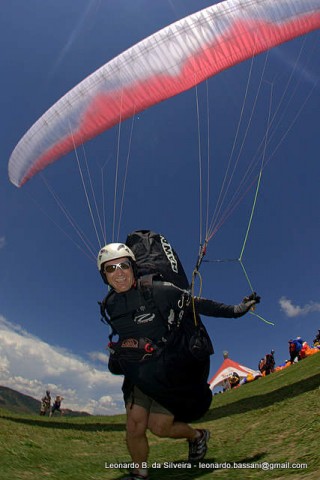
Andreas launching his Ozone R10.2
APCO Light Hiking Reserve Testing
MayDay Light from Apco Aviation on Vimeo.
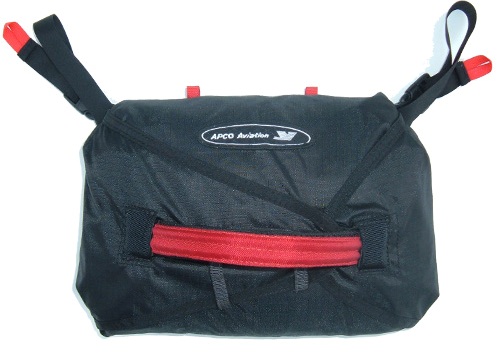
APCO MayDay Superlight Reserve Container
We have sold many of these great reserves, compact and light and they fit in all harnesses and containers easily. They are very affordable compared to some euro brands, and we stock them here at Eagle Ranch. The APCO front mount container that comes with them is the best I have seen in years.
Ozone and the new BBHPP Performance Video
The Ozone Performance Project from Ozone Films on Vimeo.
More videos here including flight tests
Olympics 2010 Airspace Closures in the Vancouver BC Region
I went to the Abbotsford informational meeting, and the plans are intense, that's for sure.
I'll boil it all down to 3 easy points for 99% of the PG and HG activity that the WCSC concerns itself with:
1 - Generally, the temporary airspace changes don't really affect PG/HG flying in the Fraser Valley That includes flying from, and near, Woodside, Bridal Falls, and Sumas.
** That said, because there are incredible restrictions to all OTHER forms of aviation basically from Langley to the US border to Victoria to Whistler and everything in between, I suspect we're going to see a TON more flying in and around our flying sites. We'll have lots of planes, heli's, ultralights and military flying over Harrison Mills, Rowena's, the golf course, the river(s), etc. So, keep your eyes open while in the air.
2 - On the contrary, PG and HG flying anywhere in Grouse Mountain, Whistler AND Pemberton is completely prohibited. No flying activity whatsoever by HG and PG pilots is permitted - No 1200 ft terrain following altitude - Nada. So, from 29 January to 24 March (time includes the paralympic games as well, remember), DO NOT FLY THERE!
Kite Surfing, paraglider kiting and hanggliding training hill flights are also prohibited within the zones.
3 - These rules are in place from 29 Jan 2010 through to 24 Mar 2010 inclusive, which includes the opening ceremonies of the Olympics, right through to the closing ceremonies of the Paralympics.
So, all in all, no biggie for us valley pilots, but a total shutdown for Grouse and Pembie.
It's only for 2 months though, so enjoy the games, and look forward to April!
Robin
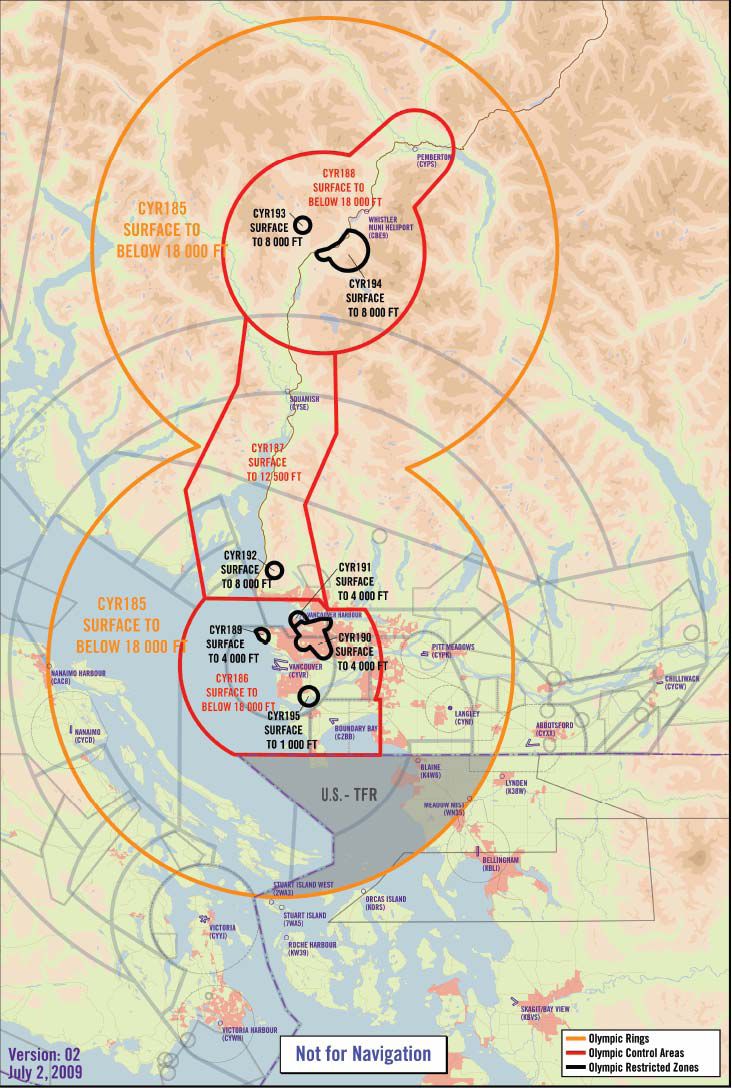
Olympic Airspace Closures Map by TC.GC.CA
Ozone releases a video report on the new Ozone BBHPP Competiton prototype that won 1st and 2nd place in the PWC 2009
The Ozone BBHPP from Ozone Films on Vimeo.
Ozone and the new BBHPP Performance Video
The Ozone Performance Project from Ozone Films on Vimeo.
More videos here including flight tests
Ozone releases the Swift Hiking Glider concept in September 2009
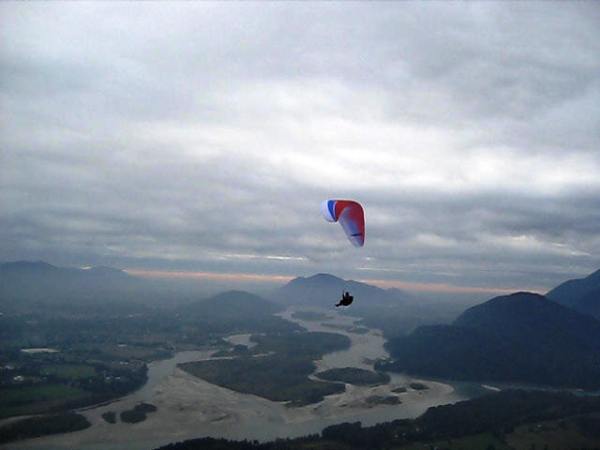
Kevin's new Ozone Swift - photo by JPR
Ozone Swift Test Report - Swift- "Mountain wing of the Decade".
When I confirmed the rumours about the Ozone Swift with Jim Reich from FlyBC I became very excited about the philosophy behind the concept. Ozone has always had the ability to recognize and carve out the �right� design for specialized piloting, I view it as a "Zen" in their design.
My interests fall in the somewhere in the genre of para- hiking, mountaineering and big ascents. I own an Ozone Mantra II for Xcross and the rock solid Ozone Geo II for exploration flying. The Geo was the tip of the iceberg for Ozone innovation, as this lead to a new line of thinking for mountaineering flying from speed flying; to the ultra light series (I flew the 2.3 kg Ozone UL 19 from Mt Baker � thank you FlyBC). However, in my opinion, there was a missing link; a wing with a solid base for safety (like the Geo) and performance responsiveness (Mantra). Then came along the Swift.
The maiden flight on the Swift was on a warmer than usual Fraser Valley October day with excellent winds. There was a small group of friends, all exceptional pilots at Woodside launch to include Kevin A, Alex R., Rob S. and Nicole M. With these pilots in the air I was able to fly side by side, up and down to see how this bird would compare.
As I unfolded the wing it is immediately obvious how simple the lines cascade and sensible the color coding, great when untangling in an alpine field.
The launch was perfect; very light going up, straight and easy to ground handle. The first thing I noticed as I turned right was how light the controls were, the second thing I noticed was the effortless weight shifting and how quickly I was in tune to a flat and fast turn.
With sharper turns and easy 1.2 meter lift, I was easily above launch and in the band width of the other pilots. I thought "very impressive, indeed, for a DHV 1-2 wing! With the Geo I would have taken much longer to get here! ". The speed was the surprising part, although I did not have a GPS and cannot verify exact speed, I was easily weaving in and out and with the other pilots with much faster high performing wings, (not say I was racing - these pilots are some of our best , I was only observing).
While flying I performed the standard �easy� stuff; big ears, wing over, spiral symmetric collapse with predicable and fast DHV 1-2 responses. After over an hour it was time to land this bird in the Riverside LZ with everyone else soon to land with me. Kevin asked what did I think, I said that this was �the mountaineering wing of the decade�, it meets all my criteria for high altitude and the pure joy of flying. I am looking forward to taking this wing into some �smoking� condition at Casa del Pilot in Mexico to see how the bird flies.
Ozone really got it right with the newly released Swift paraglider, with awesome all round performance, speed and design with the lightest possible material. Although the Swift (M) is a mere .75 kg lighter than Geo (MS) it flies completely different and I can carry an extra 10 kilos of gear, light more and warmer sleeping bag! Again, Thank you Jim! - Brad Henry
Flora Peak Report - After being under the weather for the last ten days, I needed some training catchup so I invited Brad Henry to join me on a parahike up Flora Peak (above Chilliwack Lake) today.
The hike was much easier than the snowy experience I had with Carl D last February. We hiked from 500-1800 meters in under three hours arriving to find perfect SE thermals.
Brad launched first and immediately gained altitude and started soaring the summit. I launched and we both played around the summit for 10 minutes before venturing south to the next unnamed summit. Brad went over and came back and then I did a run.
As I reached the ridge two things happened at once. I saw a nice big black bear running for cover from the huge "Swift" soaring overhead. The second thing was that I entered a small tight thermal which I never would have been able to core on my previous mountain wing. The Swift stayed in and I wound it up as the thermal grew stronger. Within minutes I was two to three hundred meters over the ridge and getting cold!
Brad radio'd from Flora peak saying he was feeling pretty chilly and was going to start making his way to the fire break LZ. I told him I would cruise west towards Williams Peak, several k to the west. Brad reported shortly after that he had landed in fairly turbulent conditions above the LZ so I was even more encouraged to land somewhere else.
I arrived at the ridge significantly below the summit pyramid but was encouraged by the ravens soaring to the west. Sure enough I hit another light thermal and worked it, getting more and more excited at the possibility of getting to summit height (2100 m). Ten minutes later, I was much higher than that. I could see that I was level with nearby Welsh Peak which is 2400 m+ and I could see Harrison lake!
I told Brad that I was heading west, and I followed the Williams/Ford Ridge eventually waving at some hikers on the Ford Mountain Lookout. Now the Forestry Nursery was in plain sight and although I didn't get any lift on the west shoulder of Ford Mtn, I flew over to Mercer hoping to get back up and cruise on to Thurston and Elk. Alas the lift was gone and after some scratching, I made my way out to the nursery choosing the western most field closest to Chilliwack Lake Road.
After a nice soft landing, I packed my gear and found my way out to the road where Brad arrived five minutes later.
We were both buzzing from the great flight, but even more so from the great performance and stability we felt from our new Swifts. Ozone you've made a winner! Jim from FlyBC, thanks for getting them for us! - Kevin A
Biff and Brad Do Flora Swiftly from Kevin Ault on Vimeo.
APCO Aviation Reserve Parachutes for 2009
After helping out the WCSC inspecting and repacking several other manufacturer's reserves at their annual Chute Clinic, I was further impressed by the APCO MayDay parachutes and some of the innovative safety features built-in that many may not know of or have never noticed. These innovations come at a very reasonable price typically $650 for a MayDay 16 good to 105 kgs all up weight.
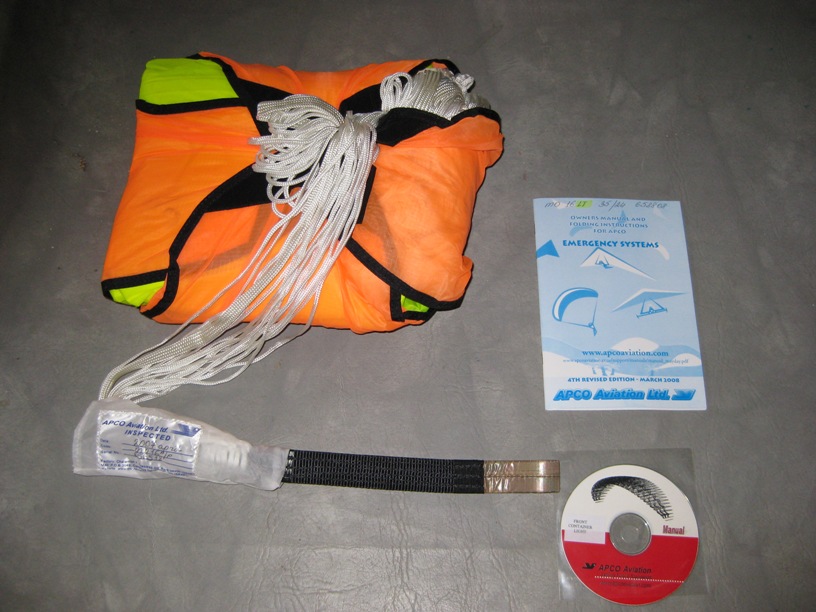
The APCO MayDay 16 in Paraglider Format with universal diaper bag ready for installation in most harnesses.
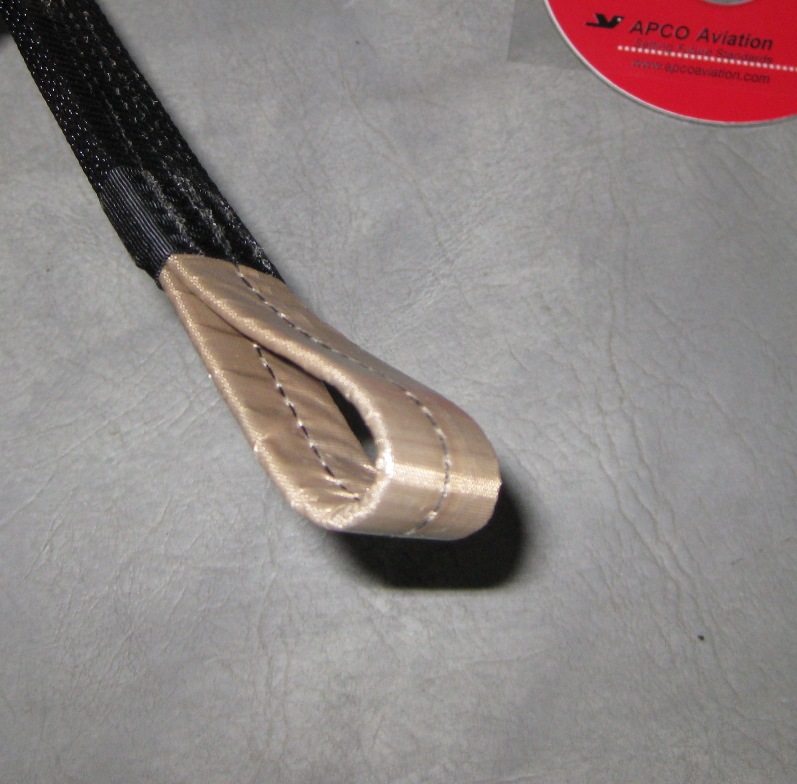
Some of the innovations include teflon coated bridle attach points to ensure the bridle can not cut through from small biners or "nylon to nylon" abrasion. This has been on MayDay reserves since 1995.
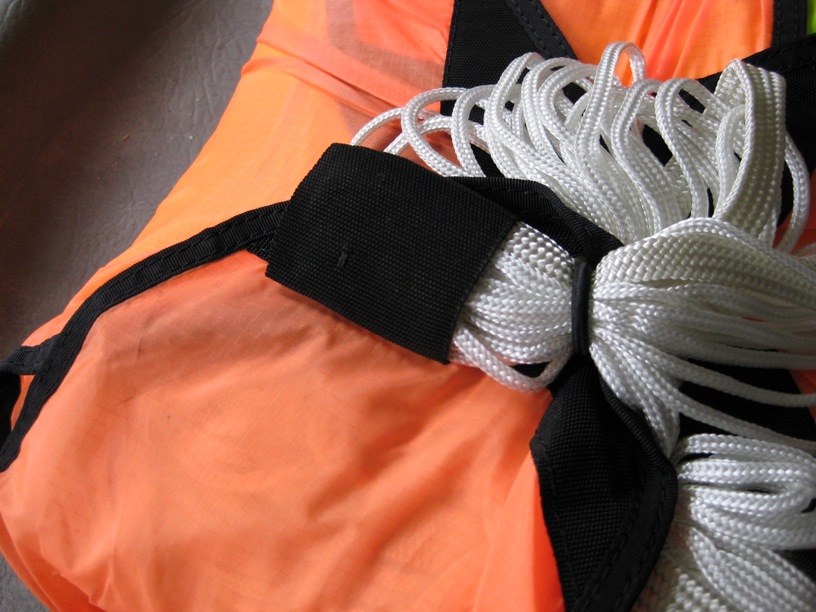
Another of the APCO innovations include the bungie protective pocket on the universal deployment bag that ensures the bungie loop is protected from line snags. This D-bag will fit on other reserves and can be purchased for $35 CDN
APCO joins the Hiking Revolution with the MayDay SuperLight Reserve in Front Mount Container
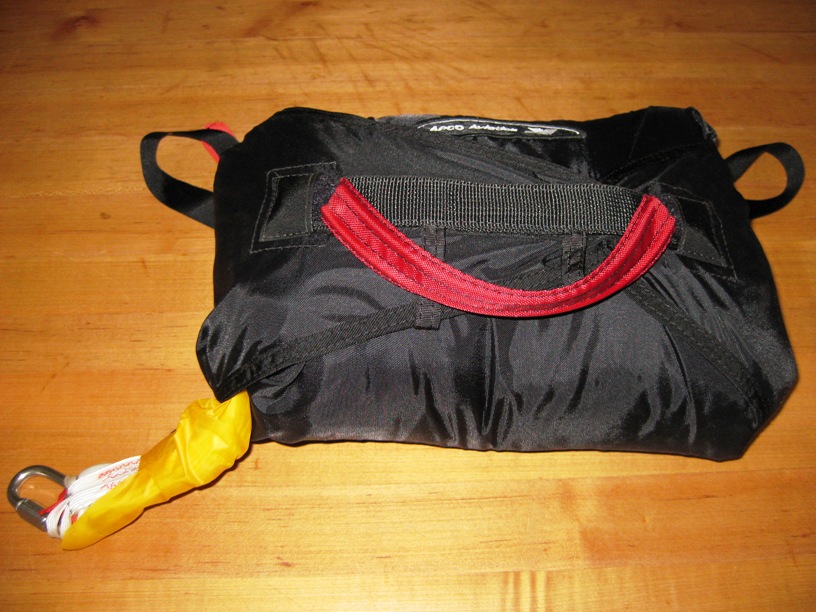
Weighing in at 1.19 kgs complete, the MayDay SuperLight Reserve in Front Mount Container offers safety and convenience for the "Hike & Fly" folks, it is also very compact for installation in smaller harnesses that are always hard to fit a regular reserve into. Call for pricing at 604-618-5467.
Ozone's Colours for 2009
of course, custom colours are available for an extra $150 CDN.

November 4, 2008 - Ozone releases the newest Comp Glider the R-09
Dav's Designer's Notes: Mantra R09
The concept: Maximum Performance in the Open Class Competition Wing Category, in order to support our international XC / Competition team.
The R07 was a well received comp wing with high performance and perhaps the best climb on the PWC and also highly comfortable � but we needed to improve on the top speed in order to have it all.
New Features:
The airfoil is a completely new type. The thickness, camber, and the general shape have all been improved, with the aim to retain the positive features of the R07 while yielding higher top speed.
Speed is a factor of wing loading: we have reduced the size to achieve a good compromise between climb rate and speed.
The arc has been revised in order to achieve the highest performance possible for this geometry. The planform remains the same except from the tip which has been redesigned to work with the new arc.
We�ve also managed to make a 15% reduction in total line drag, which translates into a straight benefit in performance!
The tension straps running across the span are now made with Mylar: This gives more cohesion to the wing, and guaranties longevity of performance.
New �shrink tabs� for the brake attachment makes the trailing edge even cleaner, and also creates more tension in the trailing edge during the turn.
Profile-enhancing rigid construction on the leading edge has also helped to give the R09 a 10kmh top speed increase! In order to maintain the shape of the nose, two types of reinforcements have been added inside and outside, at the front of the airfoil: the result is a cleaner airfoil shape, and the stability of the openings allows a higher top speed with less sail deformation � this helps prevent collapses and inefficient excessive sail movement.
The R09 is also the first model to have a new generation of trimmers. Pilots may choose either performance or stability while previously; the choice was to either set your accelerator system to one feature or the other.
Please find tech specs below. Please note that custom colors are available for the standard cost of 100 Euros extra.
|
S |
M |
L |
|
|
No. of Cells |
79 |
79 |
79 |
|
Projected Area (m2) |
20 |
21.5 |
23.2 |
|
Flat Area (m2) |
23.1 |
24.9 |
26.7 |
|
Projected Span (m) |
10.6 |
11 |
11.4 |
|
Flat Span (m) |
13 |
13.5 |
14 |
|
Projected Aspect Ratio |
5.6 |
5.6 |
5.6 |
|
Flat Aspect Ratio |
7.3 |
7.3 |
7.3 |
|
Root Chord |
2.22 |
2.31 |
2.4 |
|
Glider Weight |
6.2 |
6.5 |
6.8 |
|
In-Flight Weight Range |
90-100 |
100-110 |
110-120 |
|
Top Surface Cloth |
Skytex 45 Evolution |
||
|
Bottom Surface Cloth |
Skytex 36 Classic |
||
|
Rib cloth |
Skytex 40 Hard |
||
|
Upper lines |
Edelrid 8000U serie |
||
|
Mid lines |
Edelrid 8000U serie |
||
|
Lower Lines |
Edelrid 8000U serie |
August 8, 2008
SUP AIR SAFETY NOTICE N°3
A few harnesses equipped with light quick release buckles have experienced involuntary releases of the locking mechanism in flight and primarily with the front ( red ) Safe-T buckle.
Priority : High Publication date : August 6th 2008
Reason : The two small protruding release mechanism on the female side of the buckle, do not come back in place to secure a fully locked position.
Q : Which harness model can be affected ?
Here are the harnesses equipped by the factory with these quick release buckles: 2008 models :
ALTIX - VAMP - HYBRID - ALTIRANDO XP - VAMPAIR - X-ALPS - EVASION - XC - KINDER Airbag
2007 models :
in addition to the previously mentioned harnesses : ALTIPLUME Airbag - ESCAPE Airbag - X-Ride - X-Ride Airbag.
Note: if your harness was upgraded with the light quick release buckles, make certain to verify the stamping on the buckles and find out if they are part of the above potentially problematic series. This problem is not relevant to the harness itself but rather to the quick release light as well as the " Safe-T " buckle.
The possibly malfunctioning buckles are stamped with the following markings : A08 or B08 which corresponds to their manufacturing date ( date also indicated on the harness's label ), valid between January 2008 and July 2008. The defect is located on the female part of the buckle.
Q : What should I do if my harness is part of the list ?
Make certain the locking mechanism works smoothly and properly. To do so, proceed with the following opening and closing sequences :
1 - From a Closed / Locked buckle : symmetrically depress the two ( 2 ) release protruding levers located on either side of the female buckle, pull the male buckle out then, push / lock it back into place. The two ( 2 ) protruding levers on the female buckle section, MUST extend out FULLY again ( see graphics ). Repeat the whole sequence three ( 3 ) times. 2 - From an Open / Unlocked buckle : symmetrically depress the two ( 2 ) release protruding levers located on either side of the female buckle, and push / lock the male section into place. The two ( 2 ) protruding levers on the female buckle section, MUST extend out FULLY again ( see graphics ). Repeat the whole sequence three ( 3 ) times.
Note : Regarding the red Safe-T buckle, the test sequence MUST be repeated for both female sections on either side of the central male insert or twice per Safe-T buckle.
If, in any case, one ( 1 ) or two ( 2 ) of the protruding small levers do not come back to their initial locked position, we will ask you to contact us in order to choose the best shipping solution to send your harness back to our facility via your usual dealer or to us. Sup'Air will cover all shipping costs ( both ways ) including the necessary repairs.
Note : SUP'AIR takes pride in its manufacturing process, top quality gear and quality control. Please accept our apologies in advance for any possible inconvenience you may encounter with your harness. We will work to the best of our abilities to correct the problem and make certain you will resume flying as soon as possible with full confidence.
IMPORTANT : in any case and regardless of the quick release buckles used, you MUST and prior takeoff, run through a systematic pre-flight check list to insure for all to be properly locked and secured in place. Pay especially attention to the locking sequence and mechanism in a snowy or sandy environment. Always be VERY careful and aware of your gear's functionality. Blue skies !
--------------------------------------------------------------------------------
SUP'AIR AFTER SALES SERVICE
E-mail : info@supair.com - Tel : +33(0)4 50 45 75 29 - Fax : +33(0)4 50 52 78 70
January 15, 2008
Heading to Tenancingo, Mexico for Holidays and Flying???
Brad and Bernie's Casa is ready for you!
"Casa del Piloto" is built in classic Spanish colonial style, with a small water fountain courtyard and bright colors. For the convenience of our guest we feature a bar, chef�s kitchen and living area with fireplace, full modern amenities such as internet, TV and phone.
"La Malinche" Bedroom with one double bed and full tile bathroom attached.
"Cuatro Vientos" Bedroom with four single beds and full tile bathroom attached.
"Ixpuchiapan" Bedroom with 2 beds and access to a full tiled bathroom.
Tenancingo offers four paragliding launches a few kilometers from "Casa del Piloto" and a large LZ 300 meters from the house. For a few pesos you can take a taxi close to any launch. It is in a region of central Mexico with many other excellent alternate sites 2-4 hours away such as Valle de Bravo, Morelia , Iguala , Puebla , Fortins de las Flores and Oaxaca.
Please contact us at Casadelpiloto@gmail.com for more information.
Fly high, go far, land safe!
Bernie Scherler
Entertaining Tenanacingo Videos
Entertaining Tenanacingo Videos
Picture Gallery 1
Picture Gallery 2
December 11, 2007
New Paramotors available from FlyBC - FlyBC Paramotors using Compact Radial Engines built in Surrey BC for superior technical support. New Rhino caged MZ100 will be at the Ranch for demos soon.
November 14, 2007
PARAGLIDING OPEN DISTANCE WORLD RECORD BROKEN On November 14/2007, three of Brazil's most accomplished big distance XC pilots, Frank Brown, Rafael Salladi and Marcelo Preito, foot launched from Brazil's fabled big distance mecca of Quixada in Ceara state and flew a total of 461.8 km, landing 10 hours later!
The team took off on Sol Tracer competition wings at 07:30 and managed to climb out under a cloudy sky. They were part of a group of seven pilots, but the other four quickly went down. The team of three flew the entire day together and only landed after night had fallen.
The massive flights across the hot, dry northeast corner of Brazil finally takes Will Gadd's 2002 record of 426 km. The record had been broken by 5 km before by the Valic brothers from Da Aar in South Africa, but a technical glitch in the rules meant the FAI were unable to ratify it. Whether the team have their paper work in order and are able to get this flight ratified will remain unknown for several weeks yet.
The new record has been brewing for a while now with the team having already logged three flights over 400 km from Quixada this year.
With the record out of the way the team can focus themselves on what will be a massive milestone in the history books of paragliding: the first 500 km flight by paraglider. With other teams in South Africa and Australia waiting for conditions the race is on.
Track Logs:
Marcelo Prieto · 14.11.2007 · 467.36 km
Rafael Saladini · 14.11.2007 · 466.79 km
October 2007
Video of the New APCO Guided MayDay rogallo type reserve! available at Flybc.org.
New from APCO!!! Rogallo type steerable rescue system!!!
Fully certified by CEN to the new EN norm and approved for up to 130kg.
Finally we are launching G-MD (Guided MayDay)specially designed for the most discriminating pilot, allowing for maximum control over events in case of emergency (glider failure etc.) G-MD mainly targets pilot segment specialising in high risk applications - ACRO, industry professionals and competition pilots, but is equally appealing to the general pilot market.
G-MD deployment sequence designed to function with or without cut-off system for the main wing. Accordingly it is also attractive to weekend pilots thanks to the simplicity of use, combined with advantages offered by steerable gliding rescue system.
Glides with L/D of ~1.5 - instead of high sink rate vertical descent
Fully steerable - in same fashion as paraglider, allows for choice of landing places
Very low sink rate
High deployment reliability
Ultra fast opening with low deployment shock
Good flaring capacity on landing
Exclusive to APCO - Competitive pricing
Comes complete with brake handles and bridle/riser
G-MD SPECIFICATIONS
Area 37 m2
Gores 16
No. of Lines 25
Weight kg 2.9
Load kg 60-130
Sink Rate 2.8 m/s (90kg)
Forward Speed 15 k/h (90kg)
Glide ~ 1.5
CEN Certification According to EN 2491 up to 130kg
October 2007
New Advanced Ultralight From AviaDesign, Camarillo CA
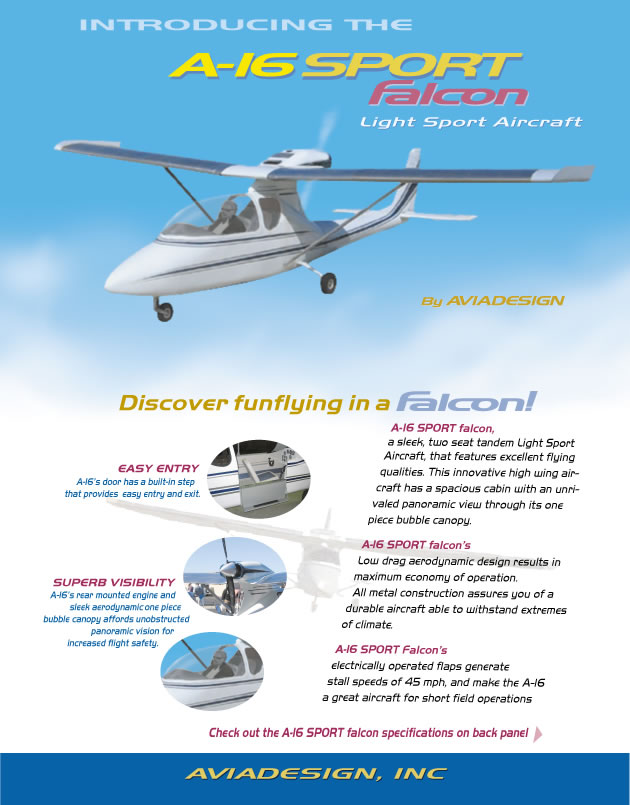

Factory Built all aluminum aircraft with excellent carrying capacities and short-field performance that allows a pilot to get in and out of his/her backyard!
Call Jim at 604-618-5467 for pricing and availability.
or email us at
February 2007
New Glider From Ozone - Buzz Z - The Solid Intermediate
Advanced profiling for efficient glide performance in active air !
Light and clean sail design for easy launching and in-flight agility.
Balanced sail tension for stability in active air and moderated glider feedback.
6 sizes enable you to choose the section of the weight range you want to fly in, and ensures you have a wing that is tailored to your size!
DHV 1-2 / EN B* Certification
The Buzz Z is a solid mid-range DHV 1-2 glider with the perfect balance between performance, fun, and safety for pilots who fly less than 50 hours per year.
Stability and comfort in active air is what sets the Buzz Z apart from the competition, and DHV 1-2 pilots can fly this glider with confidence in a wide variety of conditions. The direct handling and agile turn of the Buzz Z make it an ideal thermalling and XC glider for DHV 1-2 pilots who want to fly XC in real XC conditions, with comfort and confidence in their wing.
* Expected
Designer�s Notes >> Buzz Z
The Concept: A Better Buzz
We love the Buzz. It has been one of the more popular wings we have produced, and after more than two years it is still a favourite in the DHV 1-2 / CEN B category. The Buzz Z fits into the same category: the exact middle of the 1-2 range, with improved performance and a few subtle differences tailored to suit a wider range of pilots.
New Features:
6 sizes! We have reduced the weight range of each wing in order to make it easier for you to find the right size. This has reduced the size difference between wings to just 1.7m2 instead of nearly 2.5m2. This is a major improvement that will be particularly appreciated by pilots who have been �between� ideal weight ranges in the past.
The cell openings have been reduced, and their positioning optimised. This is to increase glide performance, but is also an important factor in low speed flight- another result of this improvement is improved low speed flying characteristics, ideal for circumstances such as top-landing.
New profile. While we wanted to maintain the stability and comfort of the Buzz profile, our testing in the past year has led to exciting new advances in profile development, and the new profile of the Buzz Z yields more glide performance and is more forgiving in deep brakes. The new profile has also improved the launching characteristics, and made the wing more spin resistant, with a more progressive feel to the brakes. The handling is more direct and the feeling is that the glider reacts to the pilots input, in exact amounts: In terms of brake input, you truly �get what you give�, when flying the Buzz Z.
More cells. With 3 more across the span, the top sail is cleaner and the cell arrangement is more balanced, improving airflow at the wingtip. This has produced a straight forward aerodynamic improvement with no sacrifice in safety.
One center cell instead of two. This has reduced the span between the center lines, improving the comfort in flight and moderating the glider�s feedback. Comfort = performance.
New diagonals. The Buzz Z features partial diagonals, which improve many aspects of the wing without increasing weight, keeping the sail light and clean, which translates directly into better handling and pitch characteristics.
New line arrangement, and internal structure. Thanks to the new diagonal design, we have reduced the line attachment points and the overall line amount by 47m. This is another �free� performance increase, with no sacrifice in safety or
Smoother Arc. A balanced and more constant arc has allowed for a slightly increased projected aspect ratio.
Materials. The new Porcher Skytex 45 Evolution has reduced the canopy weight, leading to countless advantages over the heavier Gelvenor cloth. The lighter Buzz Z inflates better, has crisper / lighter handling, and better passive safety. The Skytex cloth has proven to have better long term mechanical characteristics compared to the Gelvenor as well, meaning that the Buzz Z will last for hundreds of hours when properly cared for.
What Hasn�t Changed:
Aspect Ratio and Planform. The flat AR of 5.1 has proven to provide an excellent balance of performance and handling.
Sail Tension. Based on the same concept as the Buzz, the sail tension of the Buzz Z provides the great feeling of elasticity in the brakes, the long and progressive brake range, and its unmatched in-flight comfort in turbulent air.
February 2007
Ozone Mantra M2 Wins Overall at the Australian PG Classic!!!
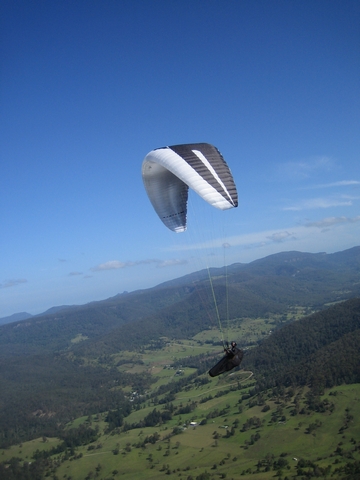
Mantra M2
Photo © David Gibbs
Gavin Zahner, flying our serial class Mantra M2, has won 1st place overall! Gavin says that the M2�s glide performance and stability on speed bar was crucial for the conditions at the comp. The DHV 2-3 certified M2 has just been released in size M, and this is the first international comp it has competed in.
In Gavin�s words:
"Maybe it shouldn�t be the Mantra M2, but the Mantra CB (Chrigel Beater) The M2 definitely hold�s it�s own in the glide department with solid performance on the bar. That was critical both days. Also I think my theory of black gliders heating up the internal air more and therefore having better glide is unquestionable now Big thanks to the ozone crew for the glider, you�re definitely hitting the performance mark with this one."
1st - ZAHNER, Gavin, - Ozone Mantra M2
2nd - MAURER, Christian - Advance Omega (proto)
3rd - HYSTEK, Phil - Gin Boomerang Sport
Congratulations on your awesome win, Gavin! Nice work! Although we�re not sure about the black fabric theory, we suspect that your win was more a result of pilot skill coupled with a glider that is just nice and comfortable to fly.
The Mantra M2 is certified DHV 2-3 and available in M size now and will be available in the S and L sizes very soon. The Mantra M2�s balance of performance and comfort must be flown to be believed, so contact FlyBC for a test flight now!
November 2006
The Mantra M2 The Mantra M2 is out there flying around in size M at the moment, and the initial feedback from our comp pilots and XC cracks is that the performance is better than anyone expected. Dav and the test team have been flying it with the Mantra R Open Class Competition wing, and in all conditions the M2 really excels, especially in turbulent air due to its stability in accelerated flight. Keep the feedback coming, we appreciate it and we�ve been quite happy to hear all of the positive comments from our pilots!
For those of you who are interested, the M2 DHV report for the size M is now on the site in English, it can be found HERE Mantra M2 Link .
Feedback suggests that the M2 has the same handling and comfort that made the Mantra so popular over the past 2 years, and it fits nicely into the middle of the DHV category. The DHV has also seen fit to not add any �Supplementary Remarks�.
November 2006
Sneak peek at the 2007 Ozone Gliders line-up new Models and Colors. FlyBC Paragliding now distributes Ozone Gliders in Canada/NW USA. OZONE Brochure06.
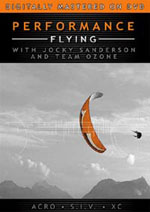
At long last . . . the Performance Flying DVD is IN STOCK at FlyBC! Price is $60 CDN.
We have finally seen the finished version, and we are quite happy to report that it is in all respects a fantastic DVD. It was professionally edited in London and NY (the sound was recorded in the BBC Studios), the content is current and clearly presented, and it is our feeling that nothing in this DVD will become outdated in any time soon. You will be able to use this DVD as a reference and an educational tool for many years to come.
Beginner Paraglider Video with Willa Lee from the Weekend Warrior taken this summer, when the weather was better. Her cameraman went tandem with me and we were able to shadow her entire flight, turning 360s around her during filming and landing before she got to Eagle Ranch, thanks to the speed difference of a Prima 24 and an Ozone Magnum tandem!
That FlyBC Girl - June 2006
Apparently, Julie made a hit at Bridal launch in June, and was crowned "That FlyBC Girl" by an un-named instructor. Not sure how to take it, I told her it was a compliment! Julie is now up to 70 flights and flying very well!

Julie K.
Ozone Magnum Tandem now in stock for demos at FlyBC - June 2006
Hi Everyone-
The Professional Choice: The Magnum is a completely new tandem wing designed for professional tandem pilots, is strong and versatile enough for any professional tandem pilot, and excels in all conditions.
We tested this new wing in a wide variety of sites to be sure that it can handle every type of flying. It launches easily in no wind, and comes up smoothly in high wind. In flight, it is pitch and roll stable for a smooth ride, and features trademark Ozone handling for precise and dynamic piloting.
Fewer diagonals and more attachment points distribute the load across the canopy more smoothly. An aspect ratio of 5.11 and 46 cells were chosen for a clean sail design and efficient performance, while still retaining benign launch characteristics and a lightweight sail design. The Magnum�s profile is a new design that was created specifically for the needs of a tandem glider. Its planform and sail tension have also been created specially for comfortable brake pressure, easy launches, and performance.
The Magnum is all Porcher Marine, with the new Porcher Skytex 45 Evolution on the topsail. This new material is extremely durable and stretch resistant, which creates a more precise feeling in flight and ensures that the glider will last for hundreds of hours.
Weight 130-220kg 46 cells, 41m and AR=5.11 flat, 35m and AR=3.7 projected. ~8.5 kg.

FlyBC's Magnum Demo Glider
Cheers,
The Ozone Team
Matt Gerdes
Ozone Paragliders
1258 Route de Grasse
06620 Le Bar-sur-Loup
France
www.flyozone.com
March 2006 - Gin Boomerang Sport DHV Report
Boomerang Sport M recently released, but back-orders are 4-6 weeks now for cash orders. Retail price is $4280 CDN plus taxes.

Flight report from Greg Babush, who is in NZ: I've had two flights on Boom Sport, sweet wing. Mr. Gin loaned me a Sport to fly this week during the pre-worlds. It has a noticably faster and better glide than the Zoom with much more precise handling and turns. Lighter brake pressure. Seems very safe: good behavior. Very responsive & super fun to fly. Lots of friends have been asking about my thoughts on the Boom Sport, and now everyone wants to get one.
Ozone Addict Colors 2006
The Addict is now available in S, M, L, and XL sizes, and in the Addict R thin line version.
The Addict R is the same solid DHV 2 XC machine as the normal Addict, but with thin lines. The thin lines have affected the gliders glide performance in turbulent air and particularly its handling, which is more direct, energetic, and precise than the normal Addict. Pilots will notice a slightly quicker turn and a more dynamic feel to the wing. Also, the Addict R tends to cut into the bumps better and there is a noticeable glide difference in headwinds and active air. The Liros DC60 upper lines reduce line drag at the bottom surface of the glider, which combined with the unsheathed Kevlar main lines creates a very light and quick feel in the air.
Pilots who fly frequently in rocky and harsh terrain will appreciate the durability of the lines on the Addict, but pilots who fly in cleaner terrain and for whom handling and glide performance are high priorities will love the feeling of the Addict R. There is no difference in safety between the Addict and Addict R.
Attached please find photos of the Green and Orange color schemes, which are the two color patterns we have not yet released. You will find photos of the other colors in the Ozone news.


New Addict Colors for 2006
Cheers,
The Ozone Team
Matt Gerdes
Ozone Paragliders
1258 Route de Grasse
06620 Le Bar-sur-Loup
France
www.flyozone.com
Ozone Buzz Report 2005
Hi Jim! My wing is sure named right, I'm still Buzz-ing from my flight yesterday!
After hiking up Elk, Monica & I watched the first group forward launch into sled ride conditions. I was the first to launch of the next group, and just as I clipped in the winds picked up. I was a little nervous as I hadn't flown in almost a month, and that had only been a winter sled ride. I waited for a lull but there wasn't one, so I tugged on my A's and poof! The Buzz came up over my head and just stayed there, waiting for me to turn and run.
I had a great launch, getting plucked off by the wind but still in control. A few seconds later I was looking down on everyone at launch - no idea how high I was as I didn't bring the added weight of my vario or gps on the hike. The wind was strong & steady and the rest of the gang rocketed off launch and soon joined me.
While the air was mostly smooth there were some rough places, whether turbulence from small ridgelines or from broken up thermals. Yes, the sun was hot enough to produce thermals - on December 11th! Anyway I was ridge soaring merrily along when I hit a rough spot. I could feel the messy patch of air through the brakes & the harness, but when I looked up the Buzz was just sitting there politely like nothing out of the ordinary was going on. This occured a few times, and each time the wing told me what was happening but stayed bombproof over head. A few gentle taps on the brakes was all I seemed to need. Needless to say I fell in love with my wing over and over on that flight.
I was debating this summer whether to go "down" to a Buzz after flying my higher end 1-2 wing for the last couple of years but I have no regrets. The Buzz gives me the confidence to stick out the flight, and not go running to the LZ after hitting a rough spot or two. I thought I would outgrow it after a few months, but this is a wing I can see myself sticking with since it makes flying so much fun! And that's the point of flying for me - to have fun.
One other note about yesterday's flight. When I came out to land I wasn't using speed bar. I didn't know my groundspeed (no GPS) but could see I had a little forward speed and not too much sink. The pilots who landed 5-15 minutes after me all reported they needed speedbar, otherwise they were going backwards. They tried to say that it was a weather system moving through, but I'm pretty sure it was the Buzz's superior glide, ha ha!
Here's a picture of Jack on his Vulcan just after launching, and I'm the tiny speck up high above him!

Jack and Martina at Elk - December 11/05
Martina
Ozone DVD Release 2005
Attached is a shot of the Ozone DVD back cover.

This year we compiled an excellent collection of paragliding and kiting short films from our team pilots and riders around the world. Guillame Broust, who edited our last DVD �Future Style� has once again created a mini-masterpiece with his 15 minute edit of the Ozone Team flying in locations around the world. It is an excellent mix of XC, Acro and soaring that can be watched again and again. The soundtrack is as unique as it is perfect, so be sure to turn up the volume for this one.
Herminio�s 5 minute short film sums up his life as an acro pilot in Caracas, Venezuela. With humor and style, Herminio shows how much is possible at even the smallest of flying sites.
Lionel Lang and Olivier Laugero spent a few months in North Africa earlier this year, shooting miles of video and thousands of photos as they raced around the desert in Olivier�s 4x4. Lio�s mini-feature about waga-madness on the African dunes is a great collection of original camera angles showing some excellent desert flying. If Olivier�s photos are worth a thousand words, this video tells an even more complete story.
In �Eiger Base�, Ozone Team Pilot Jimmy Hall recounts one of the best days of his life, jumping the North Face of the Eiger with a few good friends.
Marcus King�s edit, �Ozone Kites�, shows some of the best snow-kiting footage ever recorded. Chasta will blow your mind with kite loops and massive airs in the French Alps and Norway, among other locations.
�The Third Dimension�, by Rob Whittall, is the intro to snow kiting. Rob breaks this new and thrilling sport down into simple terms and shows the world�s best riders tearing up the slopes in the Alps and in Scandinavia.
Again, the prices are $30 CDN. Stock should be in by end of November, or drop by the Barn for a preview.
Cheers, The Ozone Team
Matt Gerdes
Ozone Paragliders
1258 Route de Grasse
06620 Le Bar-sur-Loup
France
www.flyozone.com
July 18, 2005 - Russ wins again!
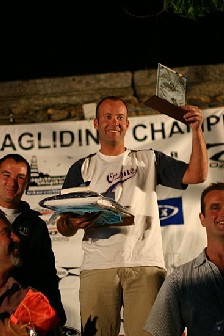 Russell Ogden, Ozone Test Pilot, has just won the second consecutive British Open PG Comp in Piedrahita, Spain. Russ also took first place in part one of the British Championships at Mayrhofen, Austria, where he was flying an earlier version of the Mantra Prototype and where Mike Cavanagh won the serial class on his Mantra M. This second victory has given Russ a 580 point lead in the British Championship.
Russell Ogden, Ozone Test Pilot, has just won the second consecutive British Open PG Comp in Piedrahita, Spain. Russ also took first place in part one of the British Championships at Mayrhofen, Austria, where he was flying an earlier version of the Mantra Prototype and where Mike Cavanagh won the serial class on his Mantra M. This second victory has given Russ a 580 point lead in the British Championship.
Russ was flying the latest Mantra Prototype, which he says was very well coordinated and nice to fly, with solid performance.
Congratulations Russ, we knew you could do it! UK PG Comps Page

Mantra Production Glider
Will Gadd wins the US Paragliding Nationals!
On a Gin Boomerang 4. Will is a Gin/Red Bull sponsored athlete and lives in Canmore Alberta, when he is not ice-climbing, record setting, free flying elsewhere.
US Nationals Results Page
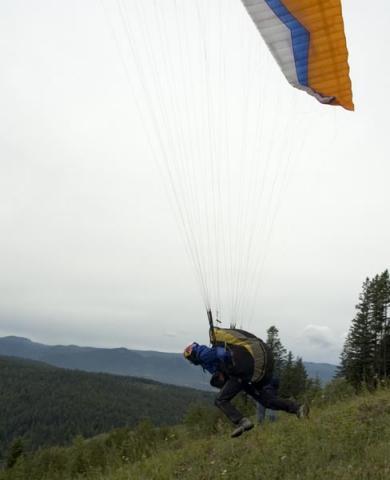 Will launching at the Canadian Nats this year.
Will launching at the Canadian Nats this year.Excellent Customer Service from Ozone!
Hi there,
I hope you�ve been enjoying your Mantra, as you know you were among the first to receive one of these gliders.
The first batch of Mantras were produced with Liros DC100 mid-lines. The Mantra was fully certified with these lines, but we have since decided to up-grade the mid-lines to make the glider even stronger and to increase its longevity.
Since yesterday, all Mantras will be made with Edelrid 8000-190 mid-lines (also fully certified), so we shall be sending you a replacement mid line-set for your glider(s) over the coming 2 weeks, and we recommend that you change them.
As you know, the Mantra was not designed with acro maneuvers in mind, however if you do wish to �throw your Mantra around� we recommend that you wait for the replacement (stronger) lines ;-)
Please (if appropriate) pass this info onto your Mantra customers.
Many thanks, Sam.
Sam Lowe
Ozone Paragliders & Kites
1258 Route de Grasse, 06620 Le Bar-sur-Loup, France
Tel: +33 (0) 4 92 60 44 00
Fax:+33 (0) 4 92 60 44 61
www.flyozone.com
Russ Ogden wins British PG Comp #1 on an Ozone Mantra proto.
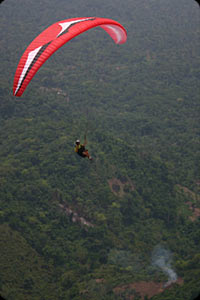
Click on Ozone Gliders for detailed information on the Mantra.
Ozone Gliders now available directly from FlyBC Airsports

Ozone has authorized FlyBC Airsports as the Western Canadian Distributor for Ozone Gliders effective March 10, 2005. Ozone wants to make their gliders more affordable and has reduced the "number of hands" that a glider has to pass through to get to the customer. FlyBC continues their relationship with SuperFly Inc. for Gin Gliders and accessories.
New gliders available include the Geo (DHV I), Buzz (DHV I-II), Rush (DHV I-II), and Mantra (DHV II-III). Call or email us for great prices!
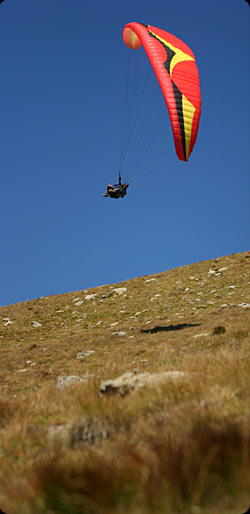 The Rush was created for the performance pilot who needs DHV 1-2 security. With a higher aspect ratio and more cells than the Buzz, the Rush is closer to the Vulcan in performance while remaining well within the boundaries of the DHV 1-2 class. It features sportier, more dynamic handling than the Buzz, along with a higher speed range.
The Rush was created for the performance pilot who needs DHV 1-2 security. With a higher aspect ratio and more cells than the Buzz, the Rush is closer to the Vulcan in performance while remaining well within the boundaries of the DHV 1-2 class. It features sportier, more dynamic handling than the Buzz, along with a higher speed range. The Rush is Cross Country Performance with safety and stability. It is a top-end DHV 1-2 with all of the ingredients for long flights; all it needs is a pilot to lead the way. The Rush's launch characteristics are benign for a wing with such performance and dynamic character, and pilots will find that the inflation is simple to control even in higher winds. The wing likes to bite into thermals and the handling is direct and well coordinated, which makes coring even the tightest or most disorganized lift a pleasure. Feedback is transmitted to the pilot in comfortable amounts, and it is feedback that the pilot can understand and use, not just turbulence or noise.
Ozone uses only the finest materials on earth to construct its gliders. The Rush's design and materials were carefully researched and tested to ensure that it will withstand the test of time.
Pilots moving up from a Vibe to a Rush will notice a very significant improvement in every aspect of the gliders' performance: With increased pitch stability in turbulence and a marked tendency to cut through the bumps and bite into lift, the Rush is an entirely different wing, with the same DHV 1-2 rating.
The Rush features Ozone's brilliant new three-color design, and is available in 8 combinations.
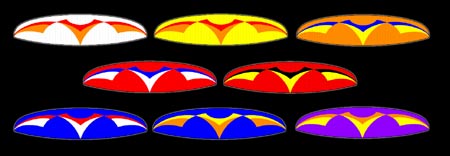
April 18, 2005 - Rush Test Flight Report - Jim Reich
Flight weight 105 kgs on a Rush Medium
Conditions were gusty at launch due to thermals.
The Rush is very light (under 6.0 kgs for the Medium), and it feels like it as it inflates easily and will overshoot in gusty winds.
In the air, the Rush feels very easy to turn and throw around into thermal cores. It climbs as good or better than the Vulcan at 45 degree bank angles.
It was a strong day and once I found a core I was at 1500 meters in about 10 minutes from Mt. Woodside (670 meters at launch). Norm was in the air on his Zoom (as was Petr), and I wasn't in the same air but I climbed past them and to at least 300 meters above them quickly, and they never tried catching me. I was hoping for a little thermal duel with Norm, that is always fun! No deflations noted despite many rough areas in the thermals, although I was flying with a wrap. Brake pressure was medium with a wrap.
I found some lighter thermals on the way to the LZ, and it was easy to flat-turn the Rush, with brakes evenly applied and weight-shifting the turn.
I did some good spirals and exits were less dynamic than the Vulcan, but still needed some brakes to arrest the surge.
Landing in thermic conditions required some moderate brake action to keep the surges down, but good energy was retained for the flare.
Overall, a really good handling glider. Light enough for the "hike & fliers", good performance (claimed speed is 53 kms/hour - DHV). Easy to throw around and bank into the strong cores. Good pricing with direct distribution from Ozone, saves about $450 per glider even with our weak buck - Jim Reich
Specifications
|
XS
|
S
|
M
|
L
|
XL
|
|
| No of Cells |
46
|
46
|
46
|
46
|
46
|
| Area Proj. |
19.28
|
21.18
|
23.00
|
25.14
|
27.55
|
| Area Flat |
22.37
|
24.57
|
26.66
|
29.16
|
32.00
|
| Span Proj. |
8.48
|
8.89
|
9.26
|
9.68
|
10.14
|
| Span Flat |
10.75
|
11.27
|
11.74
|
12.28
|
12.85
|
| AR Proj. |
3.73
|
3.73
|
3.73
|
3.73
|
3.73
|
| AR Flat |
5.17
|
5.17
|
5.17
|
5.17
|
5.17
|
| Root Chord |
2.65
|
2.77
|
2.89
|
3.02
|
3.17
|
| Glider Weight (kg) |
5.3
|
5.6
|
5.9
|
6.3
|
6.6
|
| In flight weight Range* |
55-75
|
70-90
|
85-105
|
100-120
|
115-135
|
| DHV |
1-2
|
1-2
|
1-2
|
1-2
|
1-2
|
*
weight ranges specified are all up weights including weight of the glider,
pilot and equipment
E&OE
Click
below for the Rush DHV reports.
Rush
S :: Rush
M :: Rush
XL
Colours Available
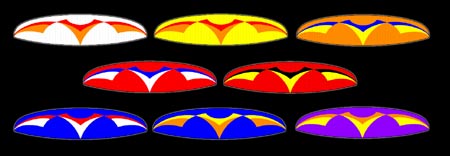
|
Materials
|
April 13, 2005 - Brauniger: Competino now available at FlyBC
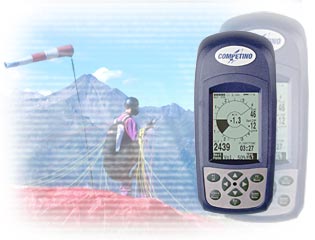 The smaller and low cost version of the IQ-COMPEO, Paragliding Flight instrument with integrated GPS receiver - retail price $1350 CDN.
The smaller and low cost version of the IQ-COMPEO, Paragliding Flight instrument with integrated GPS receiver - retail price $1350 CDN.
COMPETINO is the brand new compact flight instrument with high operator convenience especially designed for paragliders.
It has many of the approved functions of our high-end instrument IQ COMPEO as well as its high resolution display. In addition, some revolutionary additions such as 3 user selectable display representations, the unique "Track & Drop"- function for extremely accurate flights towards a goal, as well as a double power supply with normal batteries or with rechargeable batteries.
Ozone News: Mantra.
The Mantra M passed DHV today. It has been a long time coming, but we are all extremely happy with this glider. Comparative tests with other top performers in the 2-3 class have shown that the Mantra is at the top of its class.
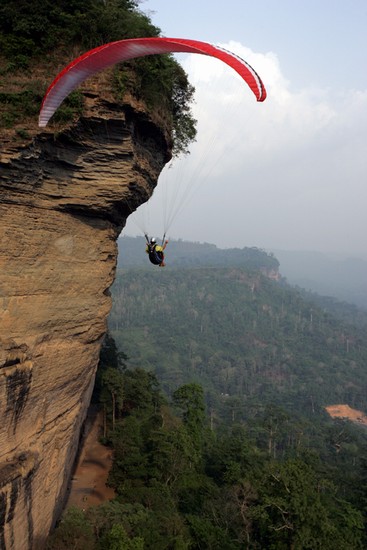 Dav�s mission on this glider was obviously to make it a high performing 2-3, but to also make it very comfortable and enjoyable to fly. We have described a little of how Dav has come to make the Mantra so comfortable in the news section of our site, which we hope that you have been following, but basically, Dav has balanced the relationship between sail tension, aspect ratio, and other factors to create a flexible and relaxed feeling in flight. A welcome result of this is a reduction in the parasitic movement of the gilder, and therefore a reduction in drag. Everyone who has flown the Mantra has said the same thing: it is stable, easy to handle, and confidence inspiring.
Dav�s mission on this glider was obviously to make it a high performing 2-3, but to also make it very comfortable and enjoyable to fly. We have described a little of how Dav has come to make the Mantra so comfortable in the news section of our site, which we hope that you have been following, but basically, Dav has balanced the relationship between sail tension, aspect ratio, and other factors to create a flexible and relaxed feeling in flight. A welcome result of this is a reduction in the parasitic movement of the gilder, and therefore a reduction in drag. Everyone who has flown the Mantra has said the same thing: it is stable, easy to handle, and confidence inspiring.
We are quite certain that this is the best performance wing that we have ever produced, and we are very excited to get it out into the market and to hear your thoughts on it.
Dav has ordered prototype XL, L, and S Mantras, and we are on schedule to begin taking orders for Mantras on the 30th April.
Most of the technical information on the wing can be found in the news pieces on our site, so please check there first if you have any questions about the glider.
Cheers, The Ozone Team
Mantra specs :
59 cells
M size 82-102kg
Glider�s weight 5.7kg
26.07m2 flat and 22.34m2 projected
AR 6.02 flat and 4.48 projected
Span 12.53m flat and 10m projected
Chord 2.6m
Certified 2-3 with unsheathed lines
Airworthiness advisory
Paraglider harness, harnesscarabiner Parafly Automatic from AustriAlpin
After several fractures of aluminium harnesscarabiner Parafly Automatic from AustriAlpin during use in 2003 and 2004, the manufacturer was asked to prove fatigue strength against vibration. The last deadline was 1. March 2005. This proof has not been shown up today. Tests conducted in the order of DHV to aluminium harnesscarabiner Parafly Automatic from AustriAlpin showed low values of fatigue strength against vibration. The in flight safety is gravely affected. The DHV has decided on the following precautionary safety measure:
All harness carabiners Parafly Automatic by Austrialpin, must not be used any more.
The airworthiness instruction comes into effect with the publishing of the NFGH (Paraglider and Hanglider news).
Gmund, 09.03.2005
Klaus Tänzler
Managing Director
New stainless steel biners are available from FlyBC for $75 per set, replace your old biners today!
Gin Zoom Race now available!
Gin Zoom Race
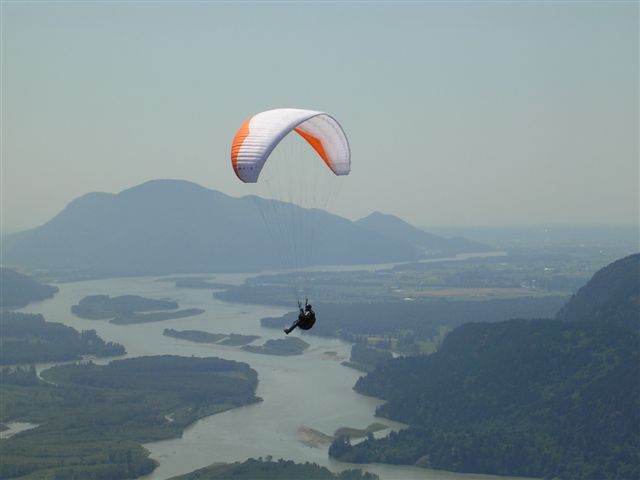
Gin Zoom crosses the Grand Canyon!
In a paraglider, completely legal.
will gadd
I and a team that included Chris Santacroce, Josh Briggs and a few others just returned from a trip where I had the amazing good fortune to fly across the Grand Canyon.
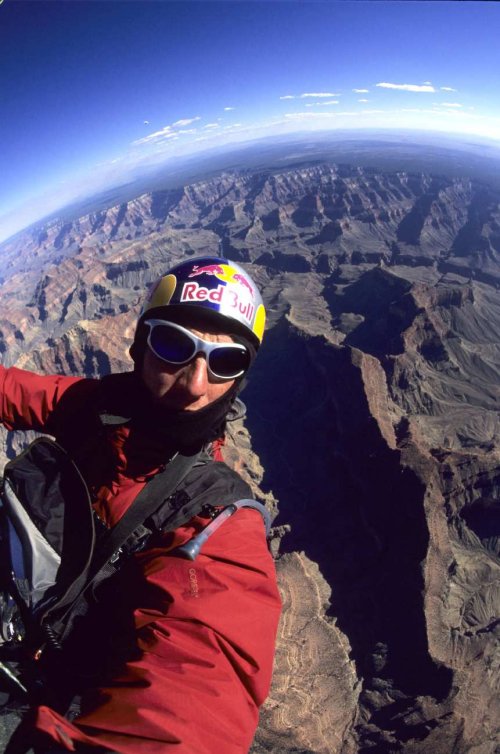
I was very careful with the airspace rules, stayed high and as far as I can figure flew it totally legally. Amazing day, base at 17,900 (really!), good light wind conditions. It was the most committed flying I've ever done--landing in there would suck.
I carried water for two days and lots of emergency supplies, but talk about messy valley winds/bad lz's! It also would be illegal due to NPS and airspace rules, etc., but it all went well.
It was an amazing feeling to be high smack dab over the middle of the Grand Canyon. We had eight days to try, I got lucky and had one day where it was perfect.
I launched by tow southwest of Grand Canyon village outside the airspace/park. Landed up by Jacob's Lake on the north side, about forty five miles of the most amazing flying I've ever experienced. Could have gone farther but was frozen, hypoxic and had other excuses.
I've been trying to find out who the hang pilots were (Bob Thompson, Hans Heindrich?) who flew across the canyon previously. There are a bunch of rumors but I can't find any facts, I'd like to talk with them about their route, share some photos, etc
September 8, 2004 - SALSA - New Intermediate wing from APCO (DHV 1-2)
The time for a new glider has arrived � finally we are launching a long-awaited DHV 1-2 - SALSA.
It has been designed to be the backbone of our 2005 range of gliders. Great attention was paid to ensure that the glider would be successful and liked by you and your pilots, justifying the hopes and promise its name carries
SALSA will be introduced in 4 sizes � covering the entire weight range up to 130 kg.
The 2 main sizes - SALSA S and SALSA M have already successfully completed DHV 1-2 certification test flights and are approved in Class DHV 1-2 trim and accelerated. The XS and L sizes will follow shortly.
Salsa in non-production colours during flight testing
Complete Salsa Press Release in Word Format
US Nationals 2004 Reserve Deployment
Steven Wilson
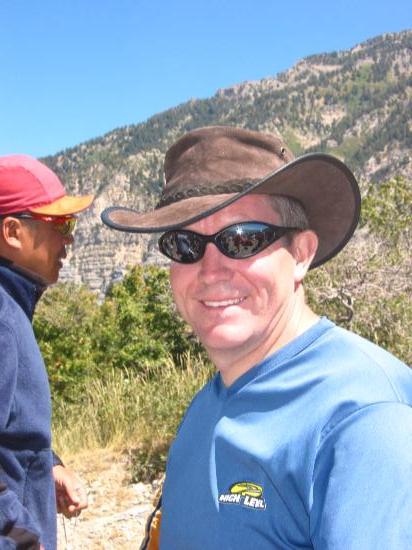
It was Saturday, August 28, 2004 just before 3:00 PM. This was only the third day that we were able to fly during the eight day competition because of uncooperative weather. We were flying south from the launch at Inspiration Point. I was running at the tail end of a large gaggle and we were flying through Rock Canyon behind BYU. Rock Canyon is a narrow steep river-cut canyon with sheer walls that reach up about 4,000 feet.
As I crossed the canyon I noticed how there were large trees growing on the cliff faces and I wondered how they managed to get so large growing on nearly bare rock. I had cleared the south edge of the canyon when I noticed that the group of wings in front of me was sinking, while the wing behind me was climbing nicely in the center of the valley. I swung around under the climbing wing and found some disorganized lift which I did not like the feel of so I headed back out of the canyon around the rim.
I was flying with light brake pressure and a very small amount of bar (1-2 inches). Just as I was crossing the edge of the canyon at about 7,500 feet ASL (and about 200 feet AGL) my wing fell behind me very quickly and asymmetrically. My first thought was that I had an asymmetric collapse and my hand dropped to pressurize the wing. This break pressure caused the wing to immediately enter a negative spin and turned me 180 degrees. My hands floundered around trying to pressurize the wing, but there was nothing there. I was being whipped violently around and I saw the rock cliffs of Rock canyon coming up very fast on my right as I spun that direction. I was flying a competition wing that I was not familiar with (I had only flown it once before the competition). My thinking was surprisingly lucid:
1) I don�t have a flying wing and it is showing now signs of recovery.
2) I don�t have time to fix my wing.
3) I don�t know if my reserve will help given the terrain I am over.
4) I don�t want to be the statistic for this year�s Nationals .
5) I don�t have any more time to think about it - THROW!
I reached down for my reserve handle. I did not think about the fact that I still had my brake in my hands since there was very little tension on the brake lines, although I probably turned myself more towards the rocks in the process. I fly an AVA Racer harness with the reserve under the front of the seat board. I pulled the handle and nothing happened. Then I REALLY pulled the handle with all the force I could muster and the reserve came out, but it also fell out of my hand before I could give it a good fling. I watched my bridle extend and I looked at the bag at the end of it, but nothing came out. Not a good feeling.
I knew that if the reserve did not deploy I was going to be in a whole lot of trouble. Just as I was thinking I needed to jerk the bag my wing gyrated hard to the left and I knew that would deploy the reserve. It did. Almost instantaneously after the jerk of the wing I heard Velcro pulling free and felt the tension of my reserve at my shoulders. My next thought was "down planing" and I looked up to see what my paraglider was doing. I never saw it, because as I looked up all I saw was tree branches racing past me. Then I stopped. From the time I felt the reserve until I was in the tree was probably only 1 second. The entire episode took less than 10 seconds Seconds matter with a reserve deployment. My reserve (which I recovered, will reuse, will recommend to others, and love) is a LARA Gold 250 and it worked like a charm. It was packed by Doug and Denise at Aerial Paragliding, although I had not had it repacked for over 2 years�which is something I will not let happen again.
To go from "I am pretty sure I am going to be severely hurt or killed in the next few seconds" to "I am hanging in a tree, unharmed" is a wonderful feeling. But I was still not sure I was safe since I had no idea if the wing was secure. I tried to look up, but I could not really see anything with the reserve bridle pressing against my helmet and I was still hearing breaking branches. I was facing a large tree truck but as I reached for it the small branches broke off in my hands. I was afraid that I would fall through the trees to the ground, about 70 feet below me (although it looked even farther because I was facing downhill on a very, very steep slope). I heard Dale Covington on the radio reporting seeing someone throwing a reserve and going into the trees. I transmitted my name and pilot number and that I was uninjured, and then I very carefully tried to swing towards the tree. I was able to grab a branch and pull myself against the trunk, which was about 12 inches around and I had good live branches around me so finally I felt secure. I then radioed my GPS coordinates. I was at 7,303 feet and the valley floor was just over 4,000 feet. I looked down to see if I could climb down. No way. Below me were all small dead branches and I could not bear-hug that far down. I had not packed my tree rescue kit which I carry when I fly in Washington because I did not think I would be flying over trees in Utah.
I ended up waiting in the tree for 3 hours. I could hear sirens and then the helicopters started to arrive. The news helicopters circled while the Lifeflight helicopter came up to check out access routes to me. I was not in an easy place to get to. At one point there was a transmission that there was a team headed up from below, which I was sure meant that I would be spending the night in the tree. One pilot who had been acting as a wind-dummy for the competition, Sebastian Meier, was sent out with a rope and a saw to look for a place to top land his paraglider and help me. He side-hilled in a very nasty area at great risk to himself, and then started the grueling 1,500 foot hike up. Dave Dixon, a pilot in the competition who also happens to be a local fireman and Captain of a technical rescue team, was flying over Rock Canyon soon after I went into the trees and he landed at the base of the canyon to coordinate retrieval efforts. I was very reassured after I heard his voice on the radio. He and his volunteer paramedic, Brady George, had the Lifeflight helicopter take them and their gear about ½ way up where they met up with Sebastian for the 2 hour hike to me. I wrapped myself in for a long wait and managed to doze on and off until they arrived 3 hours after I had gone into the tree.
When the rescue crew arrived the first thing they did was throw me a rope from the cliff next to the tree. I tied myself into the tree, lowered my gear down (which showed me that I was even higher than I thought), and tied another line to the risers of my wing as I unclipped from it. The wing was undamaged and draped over a limb above me with the lines slack. I then climbed up and cut the reserve bridle where it attached to my harness before Brady belayed me to the ground. It was good to be on the ground again.
Brady then climbed back up the tree to extract my wing and reserve. The reserve had actually capped the tree and was undamaged except for the lines which were cut to get it out of the tree.
After we had everything packed up we started the long hike out. Lifeflight had planned to pick us up where they had dropped off Dave and Brady, but they got called away so we were on our own. We only had one headlamp but we knew it was a full moon so we were not too worried. We ended up hiking down the 3,000 feet in about 2 hours�only to find a persistent local news crew waiting for us. We then headed back for the US Nationals final awards at the Point-of-the-Mountain. Len Szafaryn, the newly crowned US National champion, gave Sebastian the new harness he had one for his courageous side-hill landing to come to my aid. It was a very generous genture.
I am a P4 rated pilot who has been flying for 13 years. I have nearly 1,000 flights with just shy of 1,000 hours of flying time. I have flown about 2,000 XC miles at many different sites and in many different countries. I had taken my reserve for granted and never used it. I had never unintentionally spun a wing and thought I could keep my wing under control. All of that changed very quickly. I learned a number of lessons from this experience that I want to share:
Lessons Learned:
1) I was too close to terrain, especially in an area that looked like it would produce very trashy air. I should have given myself 500 feet AGL clearance over the rocks.
2) I should have gone hands up immediately when the wing fell behind me.
3) I should have gone hands up after I was in a negative spin (I had never spun a wing before and was not sure what was happening).
4) I probably should have released my brake before reaching for my reserve (or at least thought about it).
5) I should have carried more water. I had some but it goes quickly.
6) I will repack and remove the reserve deployment bag regularly to make sure everything will come out quickly.
7) I will carry a tree rescue kit or at LEAST some tubular webbing to secure myself to the tree with or to fling around the tree to draw myself in to the trunk. I think an 8 foot sling will be part of my flying equipment from now on.
8) I will carry a headlamp/flashlight.
9) I will have charged batteries and a backup batteries for my radio.

Hi Guys,
New addition to the Porter family on April 7, 2004. Sydney was born at 2:20 am and mum and baby are both doing great. Samantha loves having a new baby around and is really happy to be a big sister.
I am considering getting a male dog to be on my side!
Ian
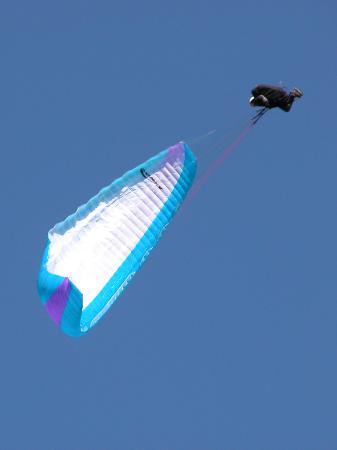
I have now bought a Sport 2M and have flown it this weekend. I fly about the middle of the weight range with a SupAir Evo harness with the chest strap wide open. I'm a reasonably experienced weekend pilot and thought about buying a Vulcan and decided I really just wanted a 1/2. Have recently flown a Mistral 2 a few times and liked that very much. Currently fly a tatty old Arcus and a Flight Design A7. Honest assessment of my skills is that the A7 is more than I want to be on in rough air but fine for Hong Kong. Don't fly in strong thermic conditions very often, and get scared by big unexpected collapses except when flying a very safe wing like the Arcus. Not an acro pilot. There must be a lot of pilots like me so this post is for them, not the super skilled die-hard acro types. If you are one of these, I don't think the Sport 2 is for you.
Flew one day in light conditions with small punchy thermals and one day in ridge lift. Construction is very good. No complaints there at all. Weight on my Medium DHV sticker says 6.5kg - more than Airwave claim. Haven't weighed it. Feels about right. Inflates very nicely in the light winds (5mph) and in the stronger winds (15mph) on the days I flew. I was surprised it inflated so easily when it has so many closed cells, but it is close to the Arcus for ease of inflation. Seems to be very pitch stable. I would think too much for acro types. Certainly more pitch stable than the Mistral 2 and A7, and maybe even more than the Arcus which surprised me. I haven't flown the Sport 1 to compare, but the Sport 2 is certainly no beast in this respect. Turns really nicely with weightshift. The only wing I have flown that turned better was the Advance Sigma 4, but the Sport 2 was close and easier to manage. The brake needed for a quick turn is reasonably light if you co-ordinate with weightshift. Without weightshift it doesn't really turn that fast, but turns are more efficient (but less fun). Much lighter than the Arcus, a bit heavier than the A7, but with a nice smooth feel. And a real joy to turn one way and then the other.
Spirals are quite easy. I never really wind them in tight, but it drops in easily, is controllable just with the inside brake, and comes out smoothly. Big ears come in easily, and come out of their own accord after a few seconds. On full speedbar the wing seemed quite fast, and the cell openings compressed slightly, but it seemed solid enough. I was in smooth air at the time though. Didn't seem to have the problems that some people have noted on the Sport 1, but then maybe I'm in for a few surprises when things hot up. I doubt it though for 2 reasons. 1 it felt pretty stable, and 2 I hardly ever use full speedbar (like most weekend pilots I suspect). Regarding performance, it is faster at trim than my Arcus and A7, and the glide seems better than both. I don't personally really care about how it compares to other 1/2s because I'm not into cross country, but performance seemed as good as any of the other wings flying with me at the weekend. So I haven't tried to assess any numbers, I leave that to those of you who care about them. It is better than my Arcus - that is good enough for me. I like thermalling and I like ridge soaring. Mostly I just like turning from side to side like on a motorbike and the Sport 2 does just what I need in this respect. I guess I'm just a big kid who never grew out of enjoying playing on a swing (and before you criticise I do know the difference between pitch and roll).
Main dislike was the long brake travel when top landing. I think the brake travel might be even longer than my Arcus when trying to go deep in the brakes (in contrast to what is needed for a quick turn) and the feel is quite spongey, but no problem getting it down. I don't like flying with a wrap, but I might have to learn to do this with this glider.
So, overall I do really like this glider right from the start and have no regrets buying it. Of course, I would have to say that wouldn't I. But I wouldn't have said the same a week after buying my A7 (which I have grown to like). I found it easy to get used to which I think is a good sign. I think I would place it as a medium 1/2. I don't think it is that hot (this is not a comment on performance - it is a comment on safety), and although it probably isn't suitable for a beginner I wouldn't be afraid to send an early club pilot off on it in the conditions I flew it in. I think Bruce Goldsmith has pretty much delivered what he has claimed in terms of making it accessible to weekend pilots. Nice one Bruce.
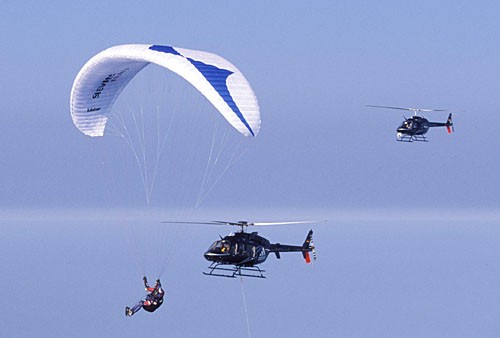
Mad Mike Küng is the first pilot to cross the English Channel on a paraglider. He launched from a helicopter at a height of 5300 metres above the French coast and set out for the glide on his OZONE Vulcan chased by a pack of helicopters. After a 40 minute flight, over a distance of 35 kilometres, he reached his goal the British coast and landed in Kingsdown near Dover. Apparently Mike wasn't allowed to land on the beach as he had hoped but instead had to drop in on a local cricket pitch. We are told he didn't miss the opportunity to show his and the Vulcan's acro skills off.
Mike had been planning this challenge for several years and now has achieved history by being the first paraglider pilot to make the crossing. Footage of his achievement has already been shown all over Europe helping to raise the profile of our sport.
Congratulations Mike, from everybody here at Ozone!!! Hope you enjoyed a fish supper after you landed - Rob Whittall
May 2003: FlyBC Improves Eagle Ranch facilities with new Training Hill and Swimming/Swoop Pond
Local contractor Danny Graham used an excavator and bulldozer to excavate the new swimming pond (100'x60'x12' deep) and used this fill to create the east facing training hill.
New students used the hill even before the grass was sprouting and it makes a huge difference in getting their ground handling skills in tune before launching on the winch or Woodside Launch.

Training Hill and Swimming Pond
Safety note:
Paraglider Ozone Atom M DHV GS-01-0844-01, Ozone Atom L DHV GS-01-0847-01, Ozone Atom S DHV GS-01-0848-01, Ozone Atom XS DHV GS-01-0928-01, serial numbers between A[Size]-D-12-101 and A[Size]-D-46-126
During the annual inspection of Atom gliders, the lower lines of some gliders with heavy use in schools have been found to have lower than expected remaining strength. Although the strength of these lines was not critically low, and no line failures in flight have been reported. Ozone Gliders Ltd. have decided to make the following Safety Notice.
All Atom XS, S, M and L with serial numbers between A[Size]-D-12-101 and A[Size]-D-46-126 the lower lines must be replaced within one year of the first flight or after 100 flying hours.
The replacement sets of lines are supplied free of charge for self fitting. If your dealer is not able to supply the replacement sets please contact either the main importer in your country or Ozone directly. A full list of ozon main importers for each country can be found on the web site www.flyozone.com
27.05.03
Ozone Gliders Ltd.
1258 Route de Grasse
F-06620 Le Bar Sur Loup
Tel +33 492 60 44 00
Fax +33 492 60 44 61
Team@flyozone.com
Dr. David Pilkington
Production manager
Airworthiness advisory
One aluminium harnesscarabiner Parafly Automatic by Austrialpin broke while starting a paraglider in the Czech Republic.This carabiner has been used over a period of two years during paragliding flight. A material investigation has been initiated immediately in the Czech Republic, the conclusion should be available in the beginning of June 2003.
The DHV has decided on the following precautionary safety measure:
All aluminium harnesscarabiners Parafly Automatic by Austrialpin, regardless the surface finishing must not be used anymore until the material investigation is finished.
The airworthiness instruction comes into force when published in the NFGH (paragliding and hanggliding news).Gmund, 21.05.2003
Klaus Tänzler
Managing Director
December 12, 2000 - Additional rescue notes
In discussion with Klaus Waldhor, local tree rescue expert after helping many pilots, suggests using a "Prusik Knot" as a safety measure when self-belaying.
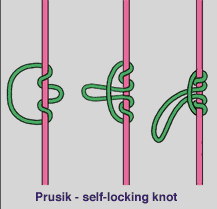 I pulled this image from from www.petzl.com and it is self explanatory. If you lost your grip or started to fall, the "prusik knot" which is attached to your harness with a biner will stop the fall automatically.
I pulled this image from from www.petzl.com and it is self explanatory. If you lost your grip or started to fall, the "prusik knot" which is attached to your harness with a biner will stop the fall automatically.I recommend all pilots should visit the www.petzl.com website for tips and tricks. Also, practice these knots and methods at home, before you need to figure them out in real life situations.